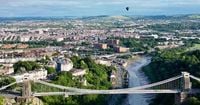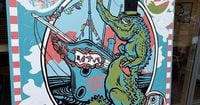It’s official: Bristol has been catapulted onto the world stage, celebrated as one of Lonely Planet’s Top 50 destinations to visit in 2026. The city’s vibrant street art scene—long a local point of pride—has finally received international recognition, with Bristol standing as the only UK city to earn a spot on the coveted list. For many Bristolians, this moment feels like the culmination of decades of creative rebellion, community spirit, and a splash of colorful mischief.
Lonely Planet’s Best in Travel 2026 guide, released on October 22, 2025, heaps praise on Bristol’s ever-changing outdoor gallery. According to the guide, “No city in Britain uses its urban landscape as a canvas quite like Bristol,” and it boasts “some of the best street art anywhere in Europe.” It’s a bold claim, but one that’s hard to dispute when you stroll through the city’s labyrinth of alleys, underpasses, and vibrant neighborhoods.
At the heart of Bristol’s artistic pulse lies a unique history. Back in the 1980s, graffiti began to appear on the city’s walls, inspired by hip hop culture and the burgeoning music scene, famously dubbed the ‘Bristol Sound.’ The Dug Out youth club in Barton Hill became a breeding ground for talent, nurturing future legends like Banksy and Inkie. John Nation, a graffiti artist, enthusiast, and ex-social worker, is often called the godfather of Bristol’s urban art movement. “Barton Hill—that’s where my journey began. I went to the youth club there and then worked there,” he recalled, reflecting on those formative years. “Graffiti culture was imported from the US shaping a whole generation. Robert Del Naja from Massive Attack, also known as 3D, was a big catalyst for that. He was pivotal as the city’s first ever graffiti writer to inspire a whole generation of ‘writers’.”
It wasn’t all smooth sailing. Early graffiti was often dismissed as vandalism, viewed with suspicion by local authorities. But as the 1990s rolled in, the scene matured. “Then in the 90s you had a proliferation of artists who had matured into adults and their styles had evolved,” said Nation. “People like Inkie, he really represents that journey it went through from its roots into more contemporary work. This is when the umbrella [term] of ‘street art’ came into fruition and Bristol became more associated with street art culture—the Banksy phenomenon.”
The distinction between graffiti and street art became clearer, with the latter gaining commercial and popular acceptance. Bristol’s walls, once battlegrounds between artists and city officials, transformed into open-air galleries. Public paint jams—where artists would cover entire blocks in murals—became legendary, and festivals like See No Evil and Upfest began drawing thousands of visitors. Steve Hayles, founder of Upfest, said the city “has always had its own beat” and that its artists “have always had something to say.” He likened street art to social media, noting, “It allows oppressed voices to be heard and shared.” He added, “I also love the way an intervention can affect somebody’s day. I remember I saw a manhole that had been painted into an egg—that made me smile. That’s the power of street art.”
Today, Bristol is known worldwide as the birthplace of Banksy, whose elusive persona and provocative murals have become synonymous with the city’s creative spirit. But Banksy is just one among hundreds of artists whose works light up the city’s streets. Internationally acclaimed talents—many of them Bristol-born—continue to leave their mark, while the city supports a thriving ecosystem of street art tours, self-guided trails, spray art workshops, and themed hotels. The biennial Upfest festival is a highlight, attracting artists and fans from around the globe.
To celebrate the city’s latest accolade, a new mural was unveiled on October 22, 2025, in Stokes Croft. Created by artist Alex Lucas, also known as Lucas Antics, the mural is a vibrant tribute to Bristol’s icons: hot air balloons, the Clifton Suspension Bridge, and the city’s own urban legend—the Bristol Crocodile. Lucas described the experience as “really, really good fun,” admitting that fitting all the elements into one piece was a challenge, but one she relished. The mural’s final location is still to be determined, but its unveiling has already generated buzz, capturing the city’s quirky, creative energy.
The Bristol Crocodile, for the uninitiated, is a local legend that began with reported sightings of a crocodile-like creature in the River Avon near Bedminster Bridge in 2014. Over the years, the story has grown, complete with makeshift warning signs and even a sculpture, cementing the creature’s place in Bristol folklore. Its inclusion in the mural is a nod to the city’s playful spirit and love of the unexpected.
Lonely Planet’s Vice President Tom Hall explained why Bristol made the cut: “Bristol’s street art scene makes for a fantastic inclusion in Best in Travel, Lonely Planet’s annual celebration of essential journeys and experiences for the coming year. As well as showcasing the talents of local artists, we’re delighted to shine a light on one of the UK’s most exciting cities. Exploring the colourful, creative murals dotted around the city is the perfect first step in getting to the heart of Bristol.” Hall also noted that the guide aims to encourage both domestic and international visitors to see Bristol in a new light, whether they’re familiar with its music and maritime history or discovering its creative side for the first time.
Patricia Yates, CEO of VisitBritain/VisitEngland, echoed Hall’s enthusiasm: “It’s no surprise Bristol is taking its place at the top table of destinations as one of Lonely Planet’s Best in Travel 2026 with the city boasting world-renowned street art and an incredible foodie scene. This well-deserved stamp of approval will encourage domestic and international visitors to explore more of what Bristol and the surrounding area have to offer and discover the creative energy and warm welcome that awaits them.”
Kathryn Davis, CEO of Visit West, highlighted the economic impact: “Our ever-evolving outdoor gallery draws thousands of visitors from around the world each year, contributing millions of pounds to the local visitor economy. We have many businesses that offer experiences supporting and championing artists and the street art scene, including Where the Wall who run Bristol Street art walking tours and stencil spray art sessions, Blackbeard 2 Banksy walking tours, Graft spray art workshops and even hotels such as Moxy Bristol and Clayton Hotel who embrace and celebrate the street art here in the city with commissioned murals in and around their properties, as well as museums, galleries and even Harvey Nichols.”
Tony Dyer, leader of Bristol City Council, summed up the city’s pride: “This is great news for our tourism industry and our city’s profile on the world stage. We want to show off our talents to the world. As a city that’s home to so many communities, each living, working and creating together, it’s no wonder that those influences have blended to create new expressions of emotion, sentiment and voice across our public and private spaces.”
With its streets as a living gallery and its creative energy now recognized around the globe, Bristol’s place among the world’s must-see cities seems more than deserved. For visitors and locals alike, there’s never been a better time to explore the city’s colorful corners and discover the stories painted on its walls.


